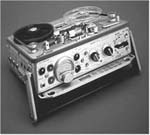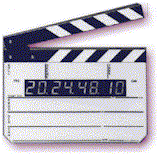In the beginning, for the timecode audio recordist anyway, there was the Nagra IV-S adapted for timecode. Eventually Nagra would have a timecode version of their own, affectionately (but unofficially) called the Nagra IV-STC. But theirs was not the first. The first viable commercial entry into this field was made by Coherent. It consisted of a very accurate timecode generator module neatly designed to be mounted beneath a Nagra IV-S recorder and a companion digital slate with an LED timecode readout. It was a very capable system, offering the necessary frame rates, jam functions, offsets, etc. for film production. It worked with the simple idea of utilizing the same frequency modulation system that the Nagra had used for recording the sync signal on its center track, but sending timecode instead of the traditional 60Hz pilot signal. It was a very good system, really, but probably for the sake of simplicity, the Nagra frequency-modulating system was not adapted as the standard for timecode recordings. Instead, recording the timecode linearly, just like the audio tracks, on the center track became the standard. So, the Coherent system had a fairly short and thankless life when the official Nagra IV-S stereo recorder was introduced in a self contained timecode version. From this point on, throughout the still remaining life of portable analog synchronous timecode recording, the Nagra IV-STC continues to reign.

Since Coherent had the first timecode adaptation for film production, they, of course, were the first to build a clap board slate with a timecode display. The Coherent slate could be had as a “smart slate”, meaning it had its own internal timecode generator, as opposed to the “dumbslate” which was only a timecode reader. The Coherent slate, while being a very respectable piece of engineering, was heavy and large to the point of being cumbersome. It went through batteries quickly and was very expensive. Its $5,000 price tag was enough to wake a sleeping giant named Michael Denecke and prompted him to design and build what would soon become the icon of timecode slates.
The Denecke TS-1 was not technically a smart slate as it was often called, but rather a dumb slate, because it did not have an internal generator. But with the Denecke’s weight, size, battery efficiency, it soon became everyone’s choice. The fact that it cost nearly $4,000 less than the Coherent may have helped too.
Since the Denecke slate did not have an internal generator, it could not be jammed to run in sync with the recorder. Also, while jam syncing is a perfectly useable method of using a smart slate when recording, it is absolutely useless with synchronous playback using timecode, such as with music video production. So, when using a dumb slate or when playing back a timecode track, there were only two options for getting timecode to a slate: The “trip wire” method mentioned above, or wireless transmitting of the timecode from the recorder to a receiver mounted on the slate. The wireless method eventually won out because of its convenience, but it was made practical because of the small size of a transmitter and receiver set made by Comtek. With the Comtek, timecode could be reliably transmitted to a slate that was a couple of hundred feet away or more. Once this was discovered, the Comtek system became the norm.
Michael Denecke, probably moved by the term “dumb slate” used to describe his Academy Award winning device, created the Sync Box, a small, self contained timecode generator. The Denecke Sync Box was accurate to within one frame in ten hours, selectable to all of the frame rates needed for film production, was powered with a nine volt battery, and fit neatly on the back of the Denecke slate, creating a genuine smart-slate. The Sync Box also has another useful but seldom-used feature: a square wave of 60Hz, 59.97Hz, or 30Hz for post production and special effects syncing, as well as a sync source for digital recorders.
We all know that competition is the mother of invention, but it can also be counted on to inspire the reinvention of the wheel. Thus another entry, the IntelliSlate, was built by PSC.
It seemed to have it all: a built-in timecode generator for jam-syncing and a slot to plug in a Comtek receiver; and all of this for a price lower than the Denecke. Actually, it was very innovative and attempted to offer features needed by the industry, and when the IntelliSlate was first introduced, people rushed to it. But once again, Father Time (Michael Denecke) awoke and answered with his current jewel, the TS-2. The TS-2 was a refined version of the TS-1 that included the Sync Box built in as an integral part of the slate. It was lighter weight than the original (because it now operated on AA cells instead of C cells), the face of the slate was sealed with a Lexan overlay to prevent Pepsi Syndrome, and it would now slide into a camera front-box like a tradition clap board. All of this for about the same price as its predecessor. Moral of this story: It’s not nice to mess with Father Time.
There is yet another timecode slate that should be mentioned here made by Ambient, of Germany. If features, ruggedness, electronic and physical precision, smallness of size, and versatility are the only criteria, the Ambient may have to be considered the best. In fact, had it entered the arena in the beginning, it may have become “The One”. However, once complexity and price are factored into the equation and possibly because it was introduce after Denecke was well established, it is understandable why it is a relatively obscure oddity.
To be fair, there are still some perfectly happy owners of the PSC IntelliSlate and the Ambient slate, and I know of at least one working Coherent Smart-Slate in existence because we sold one on consignment recently (Michael Denecke bought it). But the Denecke TS-1 and TS-2 are, by far, the most recognizable and far more likely to be seen in production today. It is the Icon. If there were a hall of fame for film production audio equipment, the Denecke slate would be there, right along side the Nagra, the Sennheiser 816 and the Rycote Windjammer.
— Glen Trew
One comment
Leave a reply Delete Message
You must be logged in to post a comment.


 US
US  Canada
Canada 
I have the Nagra slating system a Nagra pocket Time code generator reader.
Do you have information about these systems and their use?
Best Regards
Moises